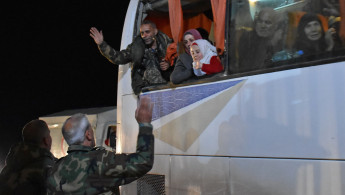Mass evacuation in Syria to proceed after deadly blast
More than 3,000 Syrians are expected to be evacuated Sunday from four areas as part of a population transfer that was briefly stalled the day before by a deadly blast that killed scores of civilians from regime loyalist areas.
The United Nations is not overseeing the transfer deal, which involves residents of the pro-government villages of Fuaa and Kafraya and the opposition-held towns of Madaya and Zabadani. All four have been under siege for years, their fate linked through a series of reciprocal agreements that the UN says have hindered aid deliveries.
Rami Abdurrahman, who heads the Britain-based Syrian Observatory for Human Rights, and Hizballah's Al-Manar TV said 3,000 people will be evacuated from Fuaa and Kafraya, while 200, the vast majority of them fighters, will be evacuated from Zabadani and Madaya.
Abdurrahman said Saturday’s blast —which hit an area where thousands of government loyalists evacuated the day before had been waiting for hours — killed 112. He said the dead included 98 people from Fuaa and Kafraya.
After the blast, some 60 buses carrying 2,200 people, including 400 opposition fighters, entered areas held by rebels in the northern province of Aleppo, Abdurrahman said.
More than 50 buses and 20 ambulances carrying some 5,000 Fuaa and Kafarya residents entered the government-held city of Aleppo, Syrian state TV said, with some of them later reaching a shelter in the village of Jibreen to the south.
UN relief coordinator Stephen O’Brien said he was “horrified” by the deadly bombing, and that while the UN was not involved in the transfer it was ready to “scale up our support to evacuees.”
He called on all parties to uphold their obligations under international humanitarian and human rights law, and to “facilitate safe and unimpeded access for the UN and its partners to bring life-saving help to those in need.”
Residents of Madaya and Zabadani, formerly summer resorts, joined the 2011 uprising against President Bashar al-Assad. Both came under government siege in the ensuing civil war.
Residents of Fuaa and Kafraya, besieged by the rebels, have lived under a steady hail of rockets and mortars for years, but were supplied with food and medicine through military airdrops.
Critics say the string of evacuations, which could see some 30,000 people moved across battle lines over the next 60 days, amounts to forced displacement along political and sectarian lines.





 Follow the Middle East's top stories in English at The New Arab on Google News
Follow the Middle East's top stories in English at The New Arab on Google News
![The UAE is widely suspected of arming the RSF militia [Getty]](/sites/default/files/styles/image_330x185/public/2024-11/GettyImages-472529908.jpg?h=69f2b9d0&itok=Yauw3YTG)
![Netanyahu furiously denounced the ICC [Getty]](/sites/default/files/styles/image_330x185/public/2024-11/GettyImages-2169352575.jpg?h=199d8c1f&itok=-vRiruf5)
![Both Hamas and the Palestinian Authority welcomed the ICC arrest warrants [Getty]](/sites/default/files/styles/image_330x185/public/2024-11/GettyImages-2178351173.jpg?h=199d8c1f&itok=TV858iVg)